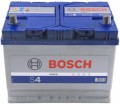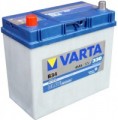Terminals
Battery terminal design. First of all, compatibility with a particular car model depends on this parameter - different automakers use different battery connection systems. Note that some types of terminals can work with "non-native" wires; however, such a connection has a number of "pitfalls", and therefore it should be used only in extreme cases and only after familiarizing yourself with all the technical nuances.
-
Cone (Euro). Contacts in the form of truncated cones that do not have any of their own clips - the role of fasteners when connecting such a battery is played by clamps on the corresponding wires of the on-board electrical network. The cones are usually recessed into the battery cover. They have a standard size: for the upper part of the positive contact it is 19.5 mm, for the negative contact it is 17.9 mm. Euro terminals are used in cars of domestic and European manufacturers.
-
Thin cone (JAP). JAP is short for Japan. Accordingly, batteries with such terminals are used mainly in cars from manufacturers from Japan and other Asian countries (therefore, the term Asia is also used for such terminals). Their design is largely similar to the Euro described above, however, the JAP cones protrude above the lid and have a smaller size - 12.7 mm and 11.1 mm for "+" and "-" respectively. Due to this, such batteries are also physically compatible with most cars under Euro, because. cl
...amps on wires are often made adjustable; in addition, the simplest adapters are also produced, which are put on the "Asian" terminals and increase their size to the "European" ones. But you can’t put a “eurobattery” on a car with JAP without replacing the mounts or using rather complicated adapters.
— Screw (USA). Unlike cones, these terminals are themselves clamps based, as the name suggests, on the use of screws. The wires under them are equipped with special contact plates (in the shape of a ring or the letter U), which are put on threaded pins; in extreme cases, you can do without such plates at all, clamping the stripped and bent ends of the wires in the mount. Such contacts are used mainly in cars of American manufacturers.
- Under the bolt (moto). Terminals designed to use contacts in the form of bolts: such a bolt, connected to a wire, is threaded into the terminal hole and fixed with a nut. Such a mount can be used in batteries for various purposes (see above), however, in this case, in accordance with the name, only "motorcycle" varieties of such terminals are meant, installed in the corresponding battery models.
- Under the bolt (boat). Bolted terminals, similar in principle to those described above for motorcycles, but used in water transport and batteries for such transport (see "Intended use").
- Petal. They have the shape of a "petal" and are represented by a quick-release connection according to the "father and mother" principle. Such connectors are good because there is no need to additionally clamp and fix the contact with a bolt / nut. As a rule, on the battery itself there is a male plug - an ordinary plate that looks like a petal. The spade-type terminal is easy to put on and take off, while providing a fairly reliable contact. Batteries with spade terminals are highly reliable and durable.Polarity
In this case, polarity refers to the location of the terminals on the battery. Traditionally, it is named according to the location of the "+" terminal when looking at the battery from the front (or, in the case of side terminals, from the side closest to which they are located).
—
+ left. In relation to passenger cars, such polarity in the CIS countries is often called "direct" or "ours". At the same time, in trucks (see "Purpose") the situation is the opposite - the left "plus" is the European standard.
—
+ right. In passenger cars, the right "plus" is typical mainly for European models, for which this polarity in the CIS countries received the unofficial name "euro" or "reverse" (as opposed to the domestic "direct"). In batteries for trucks, everything is the other way around.
— + right/ + left. This marking means that this battery model is available with both right and left “plus” (see above), and you can choose the option depending on the car model.
Note that the above division into “direct” and “reverse” polarity is not absolute, and in any case, before purchasing a battery in your car, this parameter should be clarified separately.
Battery capacity
The electrical capacity of a battery, in other words, the amount of energy stored by a battery when fully charged. The capacity value is expressed in amp-hours and indicates the number of hours during which a fully charged battery will be discharged to the minimum allowable charge, delivering a current of 1 ampere to the load. For example, a capacity of 40 Ah means that the battery is capable of delivering a current of 1 A for 40 hours, or 2 A for 20 hours, etc. In fact, a more capacious battery gives more attempts to start the engine, and is also able to work longer at a low load (for example, when powering a car audio system).
The capacity requirements for different transport types differ markedly. So, in motorcycle batteries, it rarely exceeds 20 Ah, the average value for passenger cars is 40-80 Ah (but there are options for 100 Ah or more), and for heavy equipment like buses, an acceptable capacity starts somewhere from 100 Ah. The optimal value of the battery capacity is often indicated by the manufacturer in the characteristics of the vehicle, and when choosing a model by capacity, you should focus primarily on these figures.

